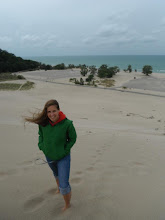I have never traveled with such a large group before. All in all, there were about 25 of us from the US, between national staff, our "ModeRADA" of the General Assembly and his wife, people from the mission co-workers' supporting Presbytery, and a random assortment of us from all over elsewhere. We were joined on the ground by aforementioned mission co-workers, the amazing Jed and Jenny, as well as a current YAV, Kyle, as well as mission co-workers from Bolivia and Colombia and some of their young adults. It was a great group, just very large.
In fact, at first, I found the group too large to step out of my comfort zone, or perhaps our collective comfort zone, and experience the new place I was in. There were plenty of pale-skinned English speakers around me at all times. I didn't have to work too hard to understand our hosts, because someone could always translate. I didn't have to think too hard about where we were going, because someone else was always in charge.
At first, this felt to me like a hindrance to our purpose in Peru. It's hard to truly dive into and experience deeply a new place with such a large group acting as a buffer, though unintentionally. This concern of mine quickly dissolved; such a large group provided a lot of thoughtful conversation about the issues at hand.
I'd like to credit some of our primary translators for making these discussions possible: Jed, Kyle, Sarah, and Valdir were four of the strongest interpreters I've ever witnessed. I relied heavily on each of them, as my Spanish background is limited to Sesame Street vocabulary and my time in Mexico, where Spanish was just a mediator between English and the local Mayan language. It was a beautiful experience to have complete thoughts carried between Spanish and English, while preserving the emotional charge of each precious idea. This made for incredibly productive conversations, and I am grateful to each of them (and many others who helped along the way).
So on this day, as I settled into the large group and language barriers, we took a very long, winding bus ride through the Andes, across the continental divide, stopping in a town called La Oroyo. Here, as we sipped coca tea to soothe my altitude sickness, we learned about some of the problems that have lead to ridiculous economic and environmental hardship.
(There are a lot of arrows pointing everywhere on this page in my journal, so bear with me.)
Historically, this was a mining region, with some smaller scale herding and gardening. Through the 60s and 70s, agriculture and livestock became mainstays in this region of Peru. Unfortunately, so did guerilla movements and internal terrorism. Violence was addressed with more violence, and communities in this part of the Andes were too isolated to help or be helped. Many people fled to Lima, leaving behind unskilled people to work the farms. This lead to an unbalanced economic system and a lot of land sales, which lead to...
- few rich families, many poor families, and a host of social problems in between
- aggregation of land and mining businesses through the 80s, which makes access to land and resources more difficult for locals
- talings and other mining waste contaminate lagoons and rivers-- you know, their source of water, of life, and the source of water for all those downstream in the desert coastal region
Mines were largely privatized by the early 2000s. It seems a lot of sketchy things are happening with contracts and deals between companies and individual families who might be desperate for something, anything at this point, since what little resources they have access to are contaminated. This becomes even more difficult and divisive because of that few wealthy families/many impoverished families detail. The rich have control of the contracts, the land, the access to resources, which only further divides them from their poor neighbors economically and socially.
So these are local problems, but they start to spiral out of control into a much larger scale, only exacerbated by large, international companies like the Chinese mining group Chinalco. The company offer work to local residents, bringing in miners as well as supporting businesses like food and transportation, ruining all local economic activity with monopoly and corruption.
This isn't even to mention the environmental issues at hand. High production of minerals like copper around the clock has lead to respiratory, skin and eye issues for the people living here. Environmental impact studies ignore indirect consequences. Over 99% of the children in La Oroyo have lead poisoning, just from living there and drinking the water.
These are problems seem nearly impossible to overcome because of the discord within the communities, as well as between the communities, as well as between the communities and the government. These broken relationships make it difficult to come together to combat such powerful companies that are destroying everything here.
These were hard lessons to learn. I found myself grateful for the camaraderie of the large group I was traveling with and the hospitality at each stop. These things helped me to process these awful stories, and although I can't say I came away with any impressive solutions to these major problems, it gave me hope that there is a community that cares. Even more hopeful is the knowledge that this community extended far beyond our delegation.
Tomorrow, Sunday, December 7: village visits to "healthy homes", and an incredible tropical glacier.

No comments:
Post a Comment